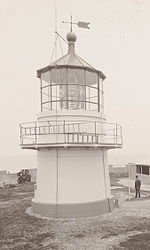SS Lindus (1881)
1871–1900 ships of Australia1881 ships1899 in AustraliaIron and steel steamships of AustraliaMaritime incidents in 1899 ... and 6 more
Merchant ship stubsMerchant ships of AustraliaShip infoboxes without an imageShips built on the River TeesShipwrecks of the Hunter RegionUse Australian English from January 2017
SS Lindus was an Australian iron-hulled coastal cargo ship driven by a 160 H.P. 2-cylinder compound steam engine with a top cruising speed of 10 knots. She was built in 1881 by Edward Withy & Co., Hartlepool, England. Her engines were built by T. Richardson & Sons, Hartlepool. She had a complement of 24 crewmembers.
Excerpt from the Wikipedia article SS Lindus (1881) (License: CC BY-SA 3.0, Authors).SS Lindus (1881)
Macquarie Pier, Newcastle-Maitland Newcastle
Geographical coordinates (GPS) Address Nearby Places Show on map
Geographical coordinates (GPS)
| Latitude | Longitude |
|---|---|
| N -32.914 ° | E 151.797 ° |
Address
Adolphe
Macquarie Pier
2300 Newcastle-Maitland, Newcastle
New South Wales, Australia
Open on Google Maps






